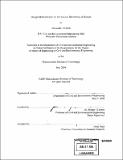| dc.contributor.advisor | Jerome J. Connor. | en_US |
| dc.contributor.author | Otenti, Alexander A. (Alexander Alfred), 1981- | en_US |
| dc.contributor.other | Massachusetts Institute of Technology. Dept. of Civil and Environmental Engineering. | en_US |
| dc.date.accessioned | 2005-10-14T20:22:48Z | |
| dc.date.available | 2005-10-14T20:22:48Z | |
| dc.date.copyright | 2004 | en_US |
| dc.date.issued | 2004 | en_US |
| dc.identifier.uri | http://hdl.handle.net/1721.1/29407 | |
| dc.description | Thesis (M. Eng.)--Massachusetts Institute of Technology, Dept. of Civil and Environmental Engineering, 2004. | en_US |
| dc.description | Includes bibliographical references (p. 52-53). | en_US |
| dc.description.abstract | This paper formulates an earthquake design strategy for bridges. Earthquakes can cause extreme economic damage and loss of life. Structural engineers must be conscience of earthquake slip type, earthquake proximity, and local soil properties when designing a structure. Structures subjected to near-field seismic events feel much complex motions and frequencies than those subjected to far-field events. When designing a structure in a seismic zone it is crucial that the engineer examine a sample of previous earthquake records from the region. Earthquake data is organized into response spectra, time histories, and frequency histories. Response spectra display the spectral displacement, velocity, and acceleration in terms of periods and are of the most interest to structural engineers. Once all of the data is gathered and organized it is necessary to decide on a retrofit strategy. Retrofitting involves either strengthening the bridge or shifting the period out of the power range of the earthquake. This paper demonstrates the effectiveness of shifting the period by base isolation with two case studies of isolated bridges and a design example. The design example is a continuation of the Waldo-Hancock Bridge Master of Engineering project completed in 2004 by the author, Andrea Scotti, and Richard Unruh. A side span of the bridge was modeled in SAP 2000 Nonlinear and subjected to the El Centro and Northridge earthquakes that struck California in 1940 and 1996, respectively. Those earthquakes were chosen because there are no recorded earthquakes in the state of Maine. | en_US |
| dc.description.abstract | (cont.) The resulting column shears and deck displacements were compared for no isolation and multiple periods of isolation. It was found that the expected result indicated by the response spectra of the two quakes closely matched the performance of the bridge. | en_US |
| dc.description.statementofresponsibility | by Alexander A. Otenti. | en_US |
| dc.format.extent | 53 p. | en_US |
| dc.format.extent | 2223287 bytes | |
| dc.format.extent | 2223096 bytes | |
| dc.format.mimetype | application/pdf | |
| dc.format.mimetype | application/pdf | |
| dc.language.iso | eng | en_US |
| dc.publisher | Massachusetts Institute of Technology | en_US |
| dc.rights | M.I.T. theses are protected by copyright. They may be viewed from this source for any purpose, but reproduction or distribution in any format is prohibited without written permission. See provided URL for inquiries about permission. | en_US |
| dc.rights.uri | http://dspace.mit.edu/handle/1721.1/7582 | |
| dc.subject | Civil and Environmental Engineering. | en_US |
| dc.title | Design methodologies for the seismic retrofitting of bridges | en_US |
| dc.type | Thesis | en_US |
| dc.description.degree | M.Eng. | en_US |
| dc.contributor.department | Massachusetts Institute of Technology. Department of Civil and Environmental Engineering | |
| dc.identifier.oclc | 56133602 | en_US |
